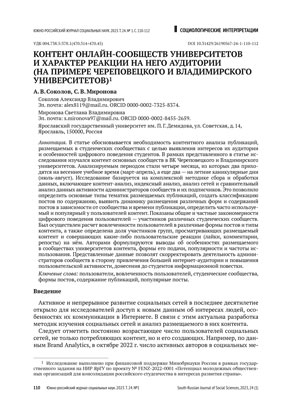Аннотация
В статье обосновывается необходимость контентного анализа публикаций, размещаемых в студенческих сообществах с целью выявления интересов их аудитории и особенностей цифрового поведения студентов. В рамках представленного в статье исследования изучался контент основных сообществ в ВК Череповецкого и Владимирского университетов. Анализируемым периодом стали четыре месяца, из которых два приходятся на весеннее учебное время (март-апрель), а еще два — на летние каникулярные дни (июль-август). Исследование базируется на комплексной методике сбора и обработки данных, включающее контент-анализ, индексный анализ, анализ сетей и сравнительный анализ данных активности администраторов сообществ и их подписчиков. Это позволило определить основные типы тематик размещаемых публикаций, создать классификацию постов по содержанию, выявить динамику размещения различных форм и содержаний постов в зависимости от сообщества и времени публикации, определить часто используемый и популярный у пользователей контент. Показаны общие и частные закономерности цифрового поведения пользователей — участников различных студенческих сообществ. Был осуществлен расчет вовлеченности пользователей в различные формы постов и типы контента, а также определена доля участников групп, просматривающих размещаемый контент и совершающих какие-либо пользовательские реакции (лайки, комментарии, репосты) на нём. Авторами формулируются выводы об особенностях размещаемого в сообществах университетов контента, формы его подачи, популярности и частоты использования. Представленные данные позволят скорректировать деятельность администраторов сообществ в сторону привлечения большей интернет-аудитории и повышения пользовательской активности, донесения до студентов информационной повестки.
Ключевые слова
Информация о финансировании
Исследование выполнено при финансовой поддержке Минобрнауки России в рамках государственного задания на НИР ЯрГУ по проекту № FENZ-2022-0001 «Потенциал молодежных общественных организаций для консолидации российского студенчества в интересах развития страны».
Библиографические ссылки
Artamonova, Yu. D., Volodenkov, S. V. (2021). Transformatsiya interneta kak prostranstva obshchestvenno-politicheskikh kommunikatsiy: ot globalizatsii k glo(lokal)anklavizatsii [Transformation of the Internet as a Space of Social and Political Communications: From Globalization to glo(local)enclave]. Sotsiologicheskiye issledovaniya [Sociological Studies], 1, 87–97. DOI: 10.31857/S013216250013572-2
Bayram Özdemir, S, Stattin, H, Özdemir, M. (2016). Youth’s Initiations of Civic and Political Discussions in Class: Do Youth’s Perceptions of Teachers’ Behaviors Matter and Why? Journal of Youth and Adolescence, 45(11), 2233–2245. DOI: 10.1007/s10964-016-0525-z
Brodovskaya, E.V., Dombrovskaya A. Yu., Lukushin V. A. (2022). Upravleniye tsifrovymi kommunikatsiyami s tselevymi gruppami v deyatel’nosti vedushchikh rossiyskikh universitetov [Management of Digital Communications with Target Groups by Leading Russian Universities]. Vyssheye obrazovaniye v Rossii [Higher education in Russia], 10, 9–24. DOI: 10.31992/0869-3617-2022-31-10-9-24
Bucher, T. (2018). If… Then. Algorithmic Power and Politics. Oxford: Oxford University Press.
Diamond, L. (2019). The Road to Digital Unfreedom: The Threat of Postmodern Totalitarianism. Journal of Democracy, 30(1), 20–24. DOI: 10.1353/jod.2019.0001
Douwes, R., Stuttaford, M. and London, L. (2018). Social Solidarity, Human Rights, and Collective Action: Considerations in the Implementation of the National Health Insurance in South Africa. Health and Human Rights, 2, 185–196.
Effektivnost’ prisutstviya vuzov Rossii v sotssetyakh [Effectiveness of Russian Universities’ Presence on the Social Media] (2020). Retrieved from https://vc.ru/social/167719-effektivnost-prisutstviya-vuzov-rossii-v-socsetyah
Manzhosov, A. E. (2018). Vovlecheniye potrebitelya v protsess sozdaniya tsennosti putem ispol’zovaniya instrumenta kastomizatsii i v seti Internet [Involving the Consumer in the Process of Creating Value through the Use of a Customization Tool and on the Internet]. Ekonomika: vchera, segodnya, zavtra [Economics: Yesterday, Today and Tomorrow], 3A, 300–307.
Martyanov, D. S., Martyanova, N. A. (2019). Upravlyayemost’ virtual’nykh soobshchestv: sravnitel’nyy analiz politizirovannykh grupp Vkontakte [Manageability of Virtual Communities: Comparative Analysis of Politicized Vkontakte Groups]. Zhurnal politicheskikh issledovaniy [Journal of Political Studies], 3, 79–93.
Rehg, W. (2007). Solidarity and the Common Good: An Analytic Framework. Journal of Social Philosophy, 38(1), 7–21.
Reynolds, L., Sariola S. (2018). The ethics and politics of community engagement in global health research. Critical Public Health, 28(3), 257–268.
Sotsial’nyye seti v Rossii: tsifry i trendy, osen’ 2022 [Social Media in Russia: Figures and Tendencies, Autumn 2022 (2022). Retrieved from https://br-analytics.ru/blog/social-media-russia-2022/
Volodenkov S. V., Belokonev S. Yu., Suslova A. A. (2021). Osobennosti struktury informatsionnogo potrebleniya sovremennoy rossiyskoy molodezhi: na materialakh issledovaniya sredi studentov-politologov Finansovogo universiteta [How Russian Youth Consume Information: Case Study of the Political Science Students of the Financial University]. Vestnik Rossiyskogo universiteta druzhby narodov. Seriya: Politologiya [Bulletin of the Peoples’ Friendship University of Russia], 1, 31–46. DOI: 10.22363/2313-1438-2021-23-1-31-46
Vse gosuchrezhdeniya v strane budut vesti svoi stranichki v sotsial’nykh setyakh [All State Institutions in the Country will Have Their Own Social Media Pages] (2022). Retrieved from https://1prime.ru/media/20221201/839012806.html
Wonneberger, A., Kim, S. J. (2017). TV News Exposure of Young People in Changing Viewing Environments: A Longitudinal, Cross-national Comparison Using People-meter Data. International Journal of Communication, 11(1), 72–93.


